Analysis of UK Business Law: Structures and IOM Solutions Report
VerifiedAdded on 2023/06/10
|7
|2280
|161
Report
AI Summary
This report provides an overview of business law in the UK, focusing on different types of business structures such as sole proprietorships, general partnerships, limited liability partnerships, and limited liability companies. It discusses the legal framework governing businesses in the UK, including the Companies Act 2006, Insolvency Act 1986, and Employment Rights Act 1996. The report also explores concepts like vicarious liability and negligence, the role of directors, and the importance of the Memorandum and Articles of Association. Furthermore, it offers recommendations for IOM Solutions, suggesting the limited liability structure for its potential benefits in market expansion and tax planning. The analysis concludes that compliance with business laws is essential for effective business management.
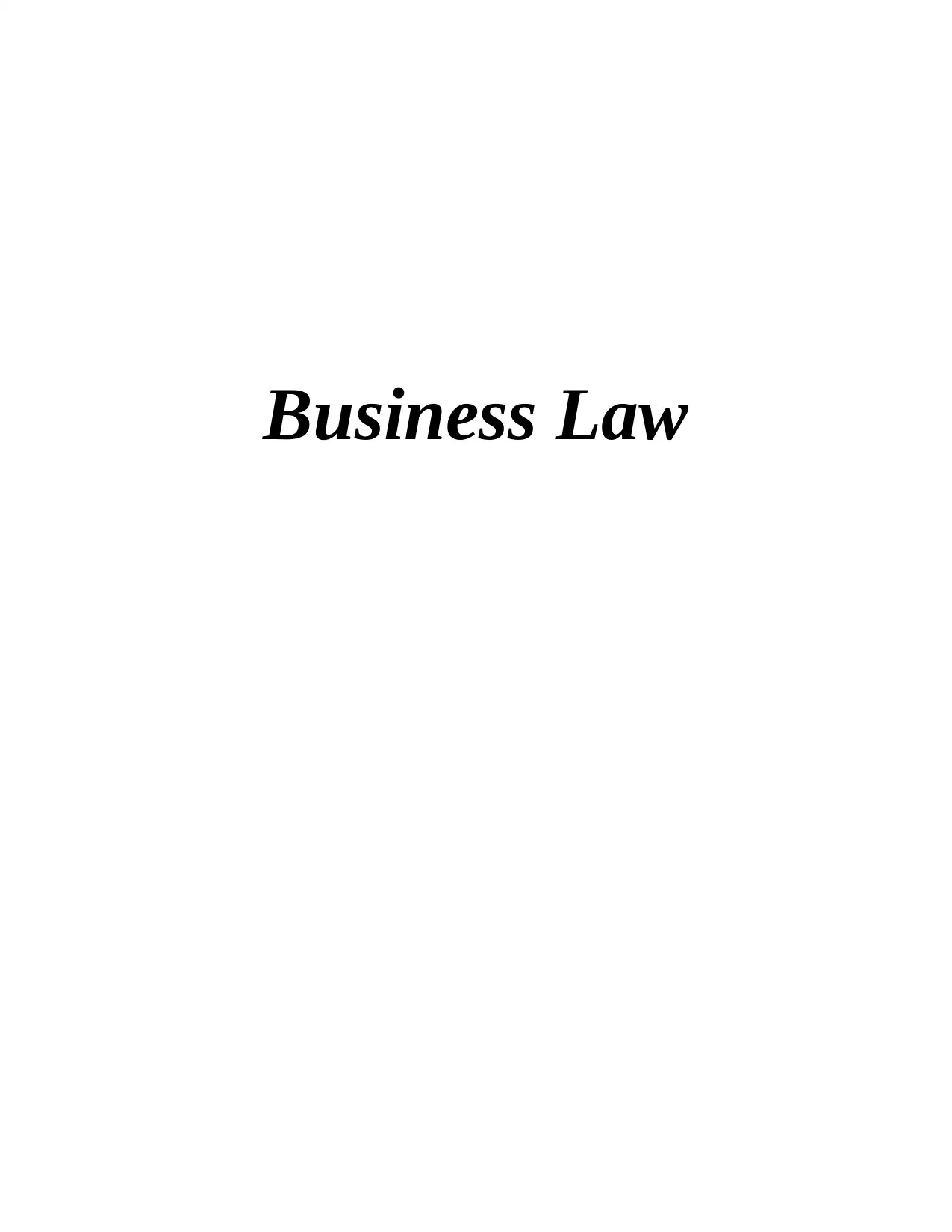
Business Law
Paraphrase This Document
Need a fresh take? Get an instant paraphrase of this document with our AI Paraphraser
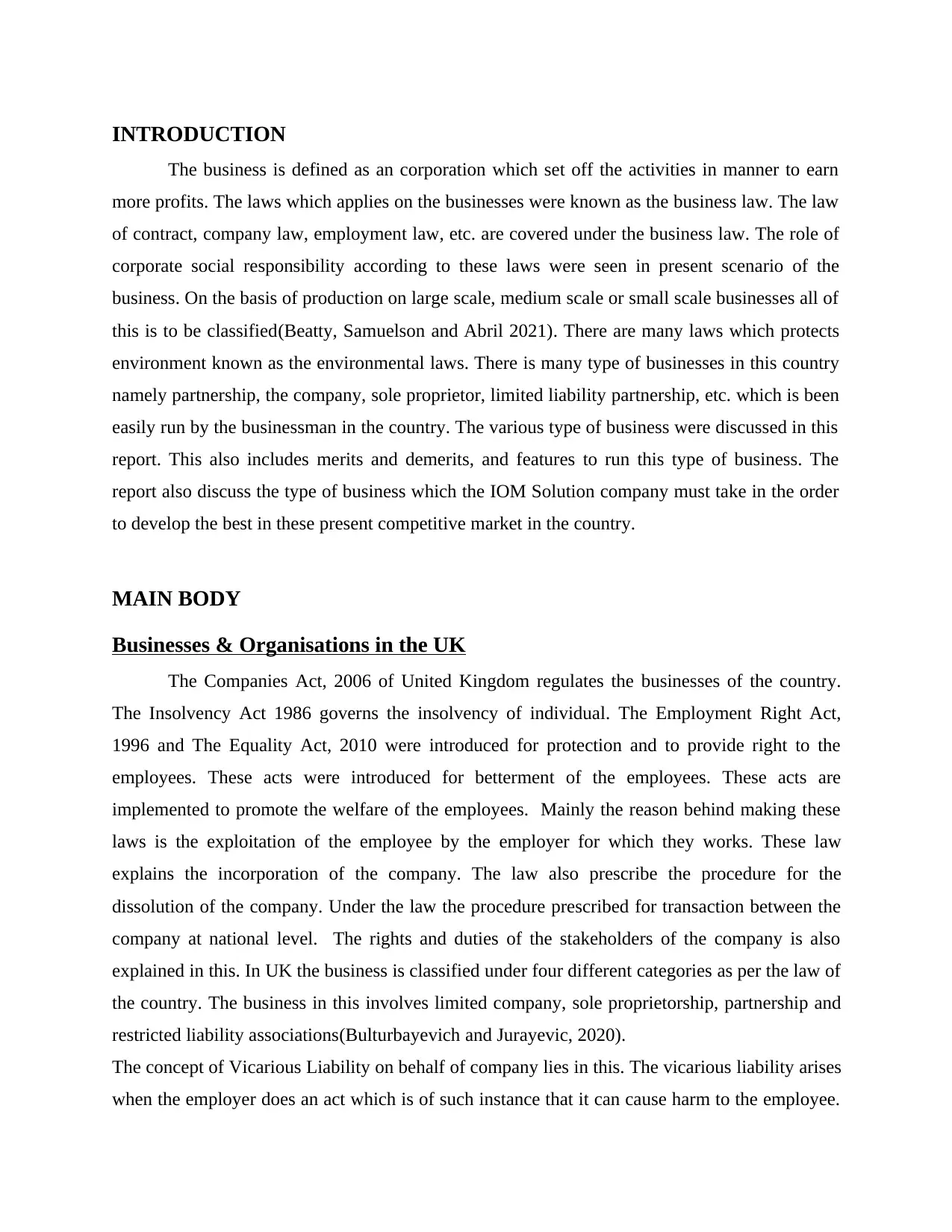
INTRODUCTION
The business is defined as an corporation which set off the activities in manner to earn
more profits. The laws which applies on the businesses were known as the business law. The law
of contract, company law, employment law, etc. are covered under the business law. The role of
corporate social responsibility according to these laws were seen in present scenario of the
business. On the basis of production on large scale, medium scale or small scale businesses all of
this is to be classified(Beatty, Samuelson and Abril 2021). There are many laws which protects
environment known as the environmental laws. There is many type of businesses in this country
namely partnership, the company, sole proprietor, limited liability partnership, etc. which is been
easily run by the businessman in the country. The various type of business were discussed in this
report. This also includes merits and demerits, and features to run this type of business. The
report also discuss the type of business which the IOM Solution company must take in the order
to develop the best in these present competitive market in the country.
MAIN BODY
Businesses & Organisations in the UK
The Companies Act, 2006 of United Kingdom regulates the businesses of the country.
The Insolvency Act 1986 governs the insolvency of individual. The Employment Right Act,
1996 and The Equality Act, 2010 were introduced for protection and to provide right to the
employees. These acts were introduced for betterment of the employees. These acts are
implemented to promote the welfare of the employees. Mainly the reason behind making these
laws is the exploitation of the employee by the employer for which they works. These law
explains the incorporation of the company. The law also prescribe the procedure for the
dissolution of the company. Under the law the procedure prescribed for transaction between the
company at national level. The rights and duties of the stakeholders of the company is also
explained in this. In UK the business is classified under four different categories as per the law of
the country. The business in this involves limited company, sole proprietorship, partnership and
restricted liability associations(Bulturbayevich and Jurayevic, 2020).
The concept of Vicarious Liability on behalf of company lies in this. The vicarious liability arises
when the employer does an act which is of such instance that it can cause harm to the employee.
The business is defined as an corporation which set off the activities in manner to earn
more profits. The laws which applies on the businesses were known as the business law. The law
of contract, company law, employment law, etc. are covered under the business law. The role of
corporate social responsibility according to these laws were seen in present scenario of the
business. On the basis of production on large scale, medium scale or small scale businesses all of
this is to be classified(Beatty, Samuelson and Abril 2021). There are many laws which protects
environment known as the environmental laws. There is many type of businesses in this country
namely partnership, the company, sole proprietor, limited liability partnership, etc. which is been
easily run by the businessman in the country. The various type of business were discussed in this
report. This also includes merits and demerits, and features to run this type of business. The
report also discuss the type of business which the IOM Solution company must take in the order
to develop the best in these present competitive market in the country.
MAIN BODY
Businesses & Organisations in the UK
The Companies Act, 2006 of United Kingdom regulates the businesses of the country.
The Insolvency Act 1986 governs the insolvency of individual. The Employment Right Act,
1996 and The Equality Act, 2010 were introduced for protection and to provide right to the
employees. These acts were introduced for betterment of the employees. These acts are
implemented to promote the welfare of the employees. Mainly the reason behind making these
laws is the exploitation of the employee by the employer for which they works. These law
explains the incorporation of the company. The law also prescribe the procedure for the
dissolution of the company. Under the law the procedure prescribed for transaction between the
company at national level. The rights and duties of the stakeholders of the company is also
explained in this. In UK the business is classified under four different categories as per the law of
the country. The business in this involves limited company, sole proprietorship, partnership and
restricted liability associations(Bulturbayevich and Jurayevic, 2020).
The concept of Vicarious Liability on behalf of company lies in this. The vicarious liability arises
when the employer does an act which is of such instance that it can cause harm to the employee.

This is the case of relationship of master and servant. The concept comes into effect because of
delegation of authority. The authority is been delegated to release the burden of work from
master. The master is bound for the act done by its servant after delegation of work. The master
is liable for the act of its servant in the case of vicarious liability.
There are three elements which satisfies the order to establish vicarious liability. The elements
are-
They must hold employer and employee relation between them.
The employee have done some tort.
The act of tort done by him have to in the course of action when employed(Chursin,
et.al., 2018).
To commit vicarious liability these elements must have to be present there. Concept of
negligence is described as if anyone did not perform the duty it is bound able to be done in the
course of business of employer. There will be loss of employees and customers of the company
if there is negligence in the company. For the act of negligence the business will be held liable to
pay the aggrieved party for the loss caused to him from any act done negligently. The employer
have to pay the compensation in monetary terms to pay for the negligence. The four basic
elements which have to be fulfilled in order to establish the negligence in a case. The four
elements have the duty to do some activity by the employer, breach of a specific duty through
employer, the result is made because of breach of duty and after all this made harm to the
aggrieved party.
The chairperson and the main head of the company are the director. The long term goals
of business are being managed and controlled by the director of the company. The legality of
business process is regulated by the director. The director will held liable for giving
authentication for the process(Davidson and Forsythe, 2020). The conflict between employees of
the company should be resolved by the director. More than one director should be there in many
instances. The number of director is also known as the Board of Directors. The decision
regarding business is been taken by the directors only. Under The Companies Act, 2006, many
power is granted to the directors. There are some different type of directors which are managing
directors, sleeping director, etc. the development plan made by the directors will succeed the
business. When the plan is effective, then only the result will be beneficial for the company. This
is the main responsibility of the director to take better decision for the company. So, in this
delegation of authority. The authority is been delegated to release the burden of work from
master. The master is bound for the act done by its servant after delegation of work. The master
is liable for the act of its servant in the case of vicarious liability.
There are three elements which satisfies the order to establish vicarious liability. The elements
are-
They must hold employer and employee relation between them.
The employee have done some tort.
The act of tort done by him have to in the course of action when employed(Chursin,
et.al., 2018).
To commit vicarious liability these elements must have to be present there. Concept of
negligence is described as if anyone did not perform the duty it is bound able to be done in the
course of business of employer. There will be loss of employees and customers of the company
if there is negligence in the company. For the act of negligence the business will be held liable to
pay the aggrieved party for the loss caused to him from any act done negligently. The employer
have to pay the compensation in monetary terms to pay for the negligence. The four basic
elements which have to be fulfilled in order to establish the negligence in a case. The four
elements have the duty to do some activity by the employer, breach of a specific duty through
employer, the result is made because of breach of duty and after all this made harm to the
aggrieved party.
The chairperson and the main head of the company are the director. The long term goals
of business are being managed and controlled by the director of the company. The legality of
business process is regulated by the director. The director will held liable for giving
authentication for the process(Davidson and Forsythe, 2020). The conflict between employees of
the company should be resolved by the director. More than one director should be there in many
instances. The number of director is also known as the Board of Directors. The decision
regarding business is been taken by the directors only. Under The Companies Act, 2006, many
power is granted to the directors. There are some different type of directors which are managing
directors, sleeping director, etc. the development plan made by the directors will succeed the
business. When the plan is effective, then only the result will be beneficial for the company. This
is the main responsibility of the director to take better decision for the company. So, in this
⊘ This is a preview!⊘
Do you want full access?
Subscribe today to unlock all pages.

Trusted by 1+ million students worldwide
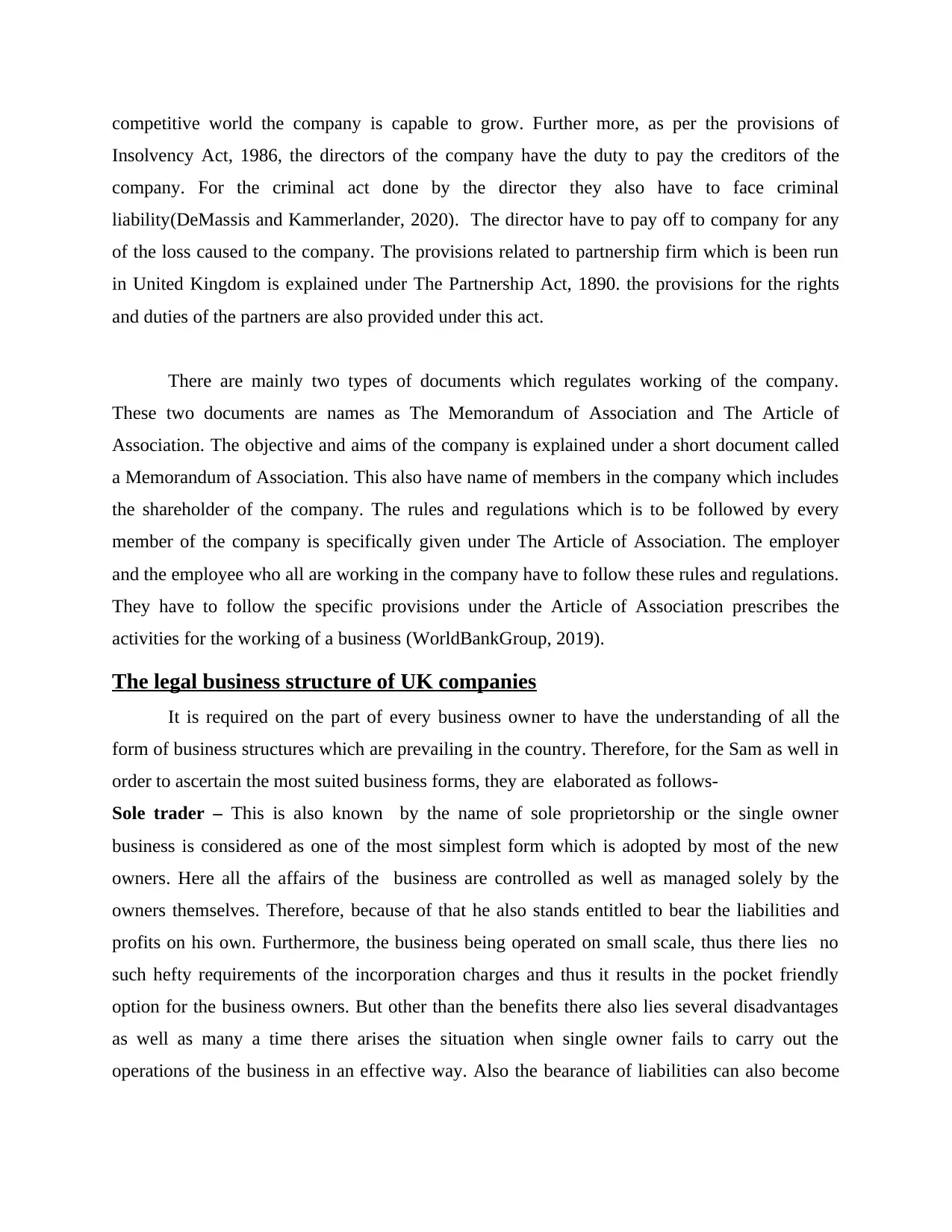
competitive world the company is capable to grow. Further more, as per the provisions of
Insolvency Act, 1986, the directors of the company have the duty to pay the creditors of the
company. For the criminal act done by the director they also have to face criminal
liability(DeMassis and Kammerlander, 2020). The director have to pay off to company for any
of the loss caused to the company. The provisions related to partnership firm which is been run
in United Kingdom is explained under The Partnership Act, 1890. the provisions for the rights
and duties of the partners are also provided under this act.
There are mainly two types of documents which regulates working of the company.
These two documents are names as The Memorandum of Association and The Article of
Association. The objective and aims of the company is explained under a short document called
a Memorandum of Association. This also have name of members in the company which includes
the shareholder of the company. The rules and regulations which is to be followed by every
member of the company is specifically given under The Article of Association. The employer
and the employee who all are working in the company have to follow these rules and regulations.
They have to follow the specific provisions under the Article of Association prescribes the
activities for the working of a business (WorldBankGroup, 2019).
The legal business structure of UK companies
It is required on the part of every business owner to have the understanding of all the
form of business structures which are prevailing in the country. Therefore, for the Sam as well in
order to ascertain the most suited business forms, they are elaborated as follows-
Sole trader – This is also known by the name of sole proprietorship or the single owner
business is considered as one of the most simplest form which is adopted by most of the new
owners. Here all the affairs of the business are controlled as well as managed solely by the
owners themselves. Therefore, because of that he also stands entitled to bear the liabilities and
profits on his own. Furthermore, the business being operated on small scale, thus there lies no
such hefty requirements of the incorporation charges and thus it results in the pocket friendly
option for the business owners. But other than the benefits there also lies several disadvantages
as well as many a time there arises the situation when single owner fails to carry out the
operations of the business in an effective way. Also the bearance of liabilities can also become
Insolvency Act, 1986, the directors of the company have the duty to pay the creditors of the
company. For the criminal act done by the director they also have to face criminal
liability(DeMassis and Kammerlander, 2020). The director have to pay off to company for any
of the loss caused to the company. The provisions related to partnership firm which is been run
in United Kingdom is explained under The Partnership Act, 1890. the provisions for the rights
and duties of the partners are also provided under this act.
There are mainly two types of documents which regulates working of the company.
These two documents are names as The Memorandum of Association and The Article of
Association. The objective and aims of the company is explained under a short document called
a Memorandum of Association. This also have name of members in the company which includes
the shareholder of the company. The rules and regulations which is to be followed by every
member of the company is specifically given under The Article of Association. The employer
and the employee who all are working in the company have to follow these rules and regulations.
They have to follow the specific provisions under the Article of Association prescribes the
activities for the working of a business (WorldBankGroup, 2019).
The legal business structure of UK companies
It is required on the part of every business owner to have the understanding of all the
form of business structures which are prevailing in the country. Therefore, for the Sam as well in
order to ascertain the most suited business forms, they are elaborated as follows-
Sole trader – This is also known by the name of sole proprietorship or the single owner
business is considered as one of the most simplest form which is adopted by most of the new
owners. Here all the affairs of the business are controlled as well as managed solely by the
owners themselves. Therefore, because of that he also stands entitled to bear the liabilities and
profits on his own. Furthermore, the business being operated on small scale, thus there lies no
such hefty requirements of the incorporation charges and thus it results in the pocket friendly
option for the business owners. But other than the benefits there also lies several disadvantages
as well as many a time there arises the situation when single owner fails to carry out the
operations of the business in an effective way. Also the bearance of liabilities can also become
Paraphrase This Document
Need a fresh take? Get an instant paraphrase of this document with our AI Paraphraser
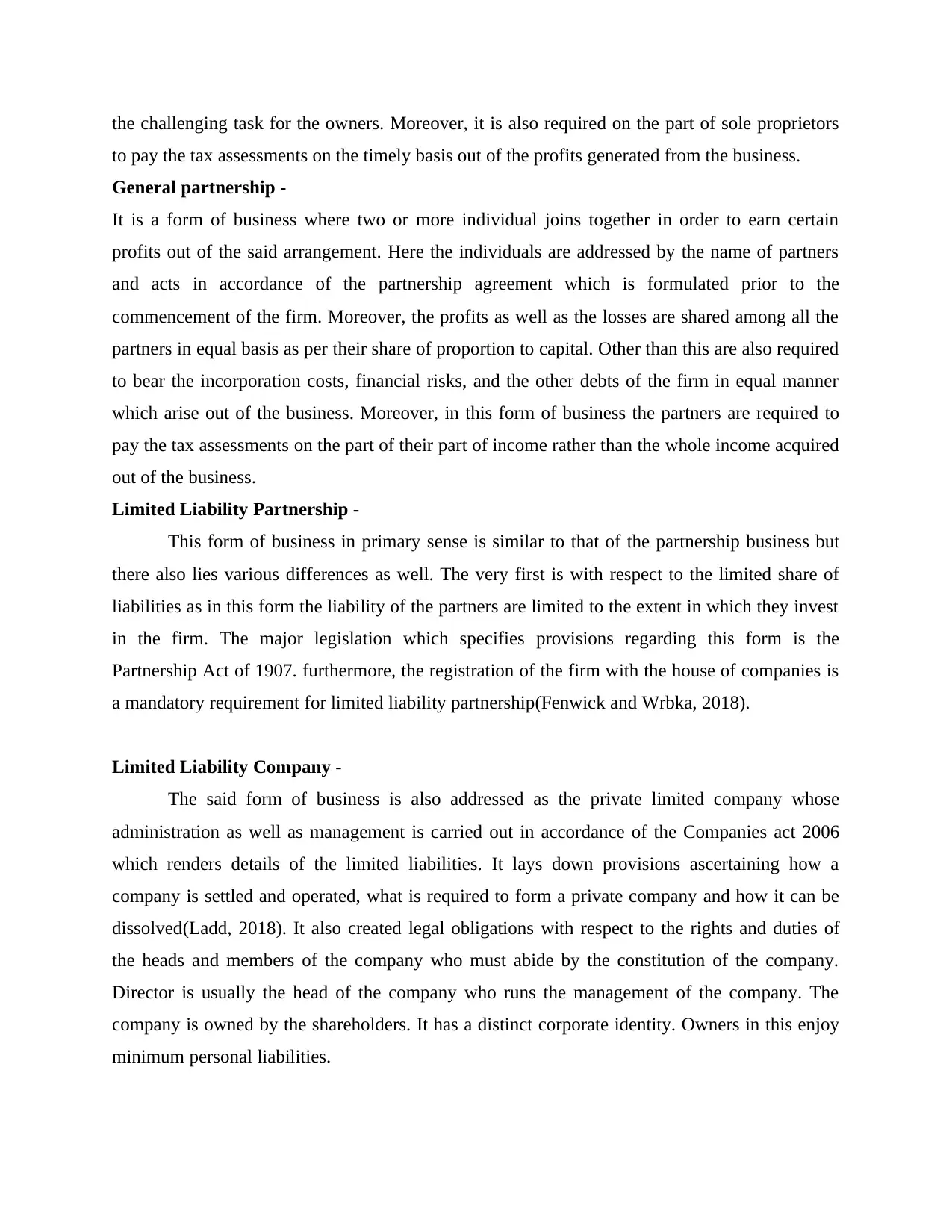
the challenging task for the owners. Moreover, it is also required on the part of sole proprietors
to pay the tax assessments on the timely basis out of the profits generated from the business.
General partnership -
It is a form of business where two or more individual joins together in order to earn certain
profits out of the said arrangement. Here the individuals are addressed by the name of partners
and acts in accordance of the partnership agreement which is formulated prior to the
commencement of the firm. Moreover, the profits as well as the losses are shared among all the
partners in equal basis as per their share of proportion to capital. Other than this are also required
to bear the incorporation costs, financial risks, and the other debts of the firm in equal manner
which arise out of the business. Moreover, in this form of business the partners are required to
pay the tax assessments on the part of their part of income rather than the whole income acquired
out of the business.
Limited Liability Partnership -
This form of business in primary sense is similar to that of the partnership business but
there also lies various differences as well. The very first is with respect to the limited share of
liabilities as in this form the liability of the partners are limited to the extent in which they invest
in the firm. The major legislation which specifies provisions regarding this form is the
Partnership Act of 1907. furthermore, the registration of the firm with the house of companies is
a mandatory requirement for limited liability partnership(Fenwick and Wrbka, 2018).
Limited Liability Company -
The said form of business is also addressed as the private limited company whose
administration as well as management is carried out in accordance of the Companies act 2006
which renders details of the limited liabilities. It lays down provisions ascertaining how a
company is settled and operated, what is required to form a private company and how it can be
dissolved(Ladd, 2018). It also created legal obligations with respect to the rights and duties of
the heads and members of the company who must abide by the constitution of the company.
Director is usually the head of the company who runs the management of the company. The
company is owned by the shareholders. It has a distinct corporate identity. Owners in this enjoy
minimum personal liabilities.
to pay the tax assessments on the timely basis out of the profits generated from the business.
General partnership -
It is a form of business where two or more individual joins together in order to earn certain
profits out of the said arrangement. Here the individuals are addressed by the name of partners
and acts in accordance of the partnership agreement which is formulated prior to the
commencement of the firm. Moreover, the profits as well as the losses are shared among all the
partners in equal basis as per their share of proportion to capital. Other than this are also required
to bear the incorporation costs, financial risks, and the other debts of the firm in equal manner
which arise out of the business. Moreover, in this form of business the partners are required to
pay the tax assessments on the part of their part of income rather than the whole income acquired
out of the business.
Limited Liability Partnership -
This form of business in primary sense is similar to that of the partnership business but
there also lies various differences as well. The very first is with respect to the limited share of
liabilities as in this form the liability of the partners are limited to the extent in which they invest
in the firm. The major legislation which specifies provisions regarding this form is the
Partnership Act of 1907. furthermore, the registration of the firm with the house of companies is
a mandatory requirement for limited liability partnership(Fenwick and Wrbka, 2018).
Limited Liability Company -
The said form of business is also addressed as the private limited company whose
administration as well as management is carried out in accordance of the Companies act 2006
which renders details of the limited liabilities. It lays down provisions ascertaining how a
company is settled and operated, what is required to form a private company and how it can be
dissolved(Ladd, 2018). It also created legal obligations with respect to the rights and duties of
the heads and members of the company who must abide by the constitution of the company.
Director is usually the head of the company who runs the management of the company. The
company is owned by the shareholders. It has a distinct corporate identity. Owners in this enjoy
minimum personal liabilities.
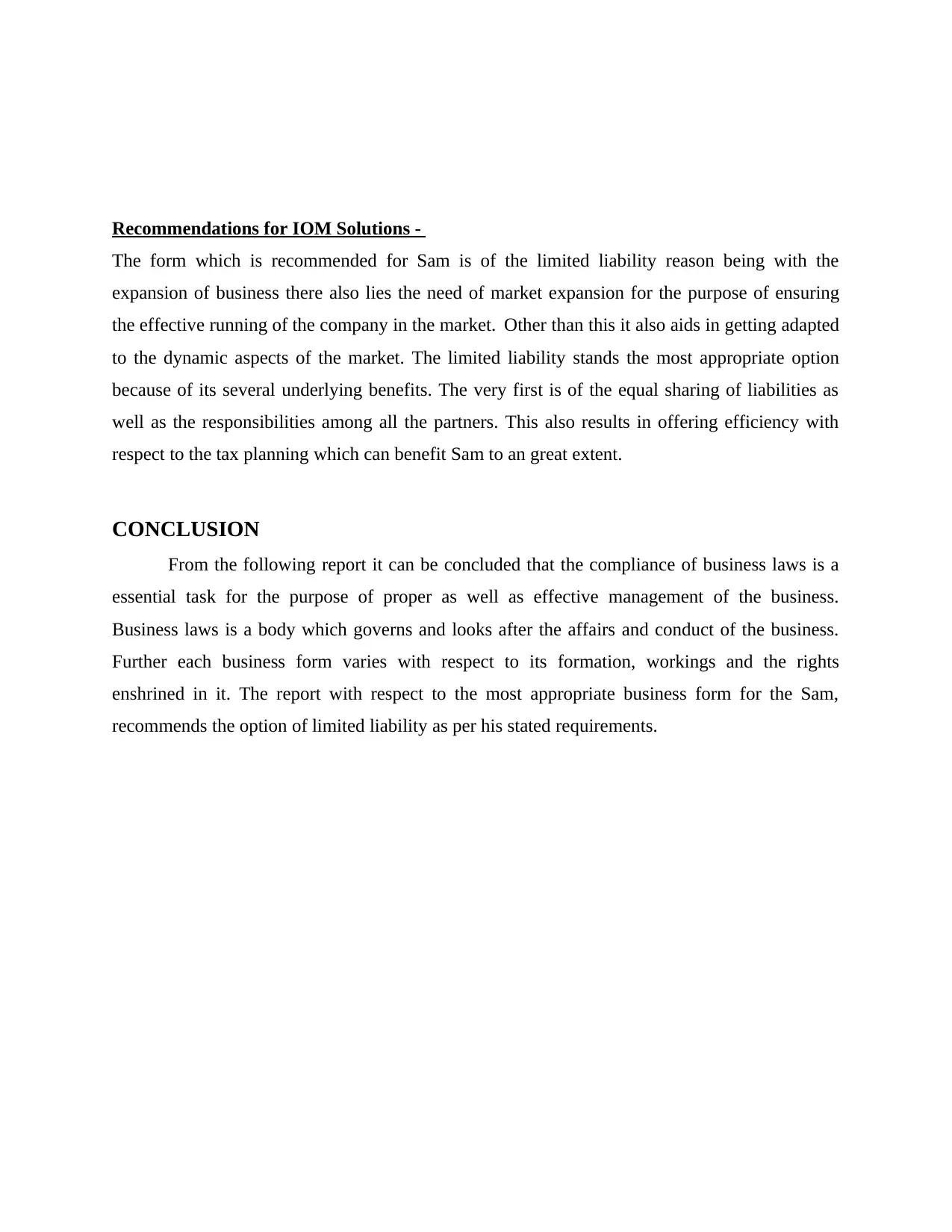
Recommendations for IOM Solutions -
The form which is recommended for Sam is of the limited liability reason being with the
expansion of business there also lies the need of market expansion for the purpose of ensuring
the effective running of the company in the market. Other than this it also aids in getting adapted
to the dynamic aspects of the market. The limited liability stands the most appropriate option
because of its several underlying benefits. The very first is of the equal sharing of liabilities as
well as the responsibilities among all the partners. This also results in offering efficiency with
respect to the tax planning which can benefit Sam to an great extent.
CONCLUSION
From the following report it can be concluded that the compliance of business laws is a
essential task for the purpose of proper as well as effective management of the business.
Business laws is a body which governs and looks after the affairs and conduct of the business.
Further each business form varies with respect to its formation, workings and the rights
enshrined in it. The report with respect to the most appropriate business form for the Sam,
recommends the option of limited liability as per his stated requirements.
The form which is recommended for Sam is of the limited liability reason being with the
expansion of business there also lies the need of market expansion for the purpose of ensuring
the effective running of the company in the market. Other than this it also aids in getting adapted
to the dynamic aspects of the market. The limited liability stands the most appropriate option
because of its several underlying benefits. The very first is of the equal sharing of liabilities as
well as the responsibilities among all the partners. This also results in offering efficiency with
respect to the tax planning which can benefit Sam to an great extent.
CONCLUSION
From the following report it can be concluded that the compliance of business laws is a
essential task for the purpose of proper as well as effective management of the business.
Business laws is a body which governs and looks after the affairs and conduct of the business.
Further each business form varies with respect to its formation, workings and the rights
enshrined in it. The report with respect to the most appropriate business form for the Sam,
recommends the option of limited liability as per his stated requirements.
⊘ This is a preview!⊘
Do you want full access?
Subscribe today to unlock all pages.

Trusted by 1+ million students worldwide

REFERENCES
Books and Journals
Beatty, J.F., Samuelson, S.S. and Abril, P., 2021. Essentials of Business Law. Cengage Learning.
Bulturbayevich, M.B. and Jurayevich, M.B., 2020. The impact of the digital economy on
economic growth. International Journal of Business, Law, and Education, 1(1), pp.4-7.
Chursin, A.A., et.al., 2018, February. The approach to detection and application of the
company’s technological competences to form a business-model. In IOP Conference
Series: Materials Science and Engineering (Vol. 312, No. 1, p. 012003). IOP Publishing.
Davidson, D.V. and Forsythe, L.M., 2020. Business law: Principles and cases in the legal
environment. Wolters Kluwer Law & Business.
De Massis, A. and Kammerlander, N. eds., 2020. Handbook of qualitative research methods for
family business. Edward Elgar Publishing.
Fenwick, M. and Wrbka, S., 2018. International business law: emerging fields of regulation.
Bloomsbury Publishing.
Ladd, T., 2018. Does the business model canvas drive venture success?. Journal of Research in
Marketing and Entrepreneurship.
World Bank Group, 2019. Women, business and the law 2019: A decade of reform. World Bank.
Books and Journals
Beatty, J.F., Samuelson, S.S. and Abril, P., 2021. Essentials of Business Law. Cengage Learning.
Bulturbayevich, M.B. and Jurayevich, M.B., 2020. The impact of the digital economy on
economic growth. International Journal of Business, Law, and Education, 1(1), pp.4-7.
Chursin, A.A., et.al., 2018, February. The approach to detection and application of the
company’s technological competences to form a business-model. In IOP Conference
Series: Materials Science and Engineering (Vol. 312, No. 1, p. 012003). IOP Publishing.
Davidson, D.V. and Forsythe, L.M., 2020. Business law: Principles and cases in the legal
environment. Wolters Kluwer Law & Business.
De Massis, A. and Kammerlander, N. eds., 2020. Handbook of qualitative research methods for
family business. Edward Elgar Publishing.
Fenwick, M. and Wrbka, S., 2018. International business law: emerging fields of regulation.
Bloomsbury Publishing.
Ladd, T., 2018. Does the business model canvas drive venture success?. Journal of Research in
Marketing and Entrepreneurship.
World Bank Group, 2019. Women, business and the law 2019: A decade of reform. World Bank.
1 out of 7
Related Documents
Your All-in-One AI-Powered Toolkit for Academic Success.
+13062052269
info@desklib.com
Available 24*7 on WhatsApp / Email
![[object Object]](/_next/static/media/star-bottom.7253800d.svg)
Unlock your academic potential
Copyright © 2020–2025 A2Z Services. All Rights Reserved. Developed and managed by ZUCOL.


